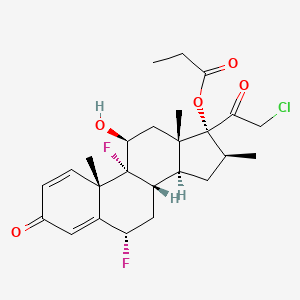D0955 | halobetasol propionate
| Toxicity | Dose | Time | Species | Model | Method | Action | Positive criterion | Reference |
|---|---|---|---|---|---|---|---|---|
| MEMBRANE POTENTIAL | 15.18±5.52 | human | qHTS-HepG2 | MMP assay | decrease | IC50 | 163 | |
| MEMBRANE POTENTIAL | 13.77 | human | HepG2 | MMP assay | decrease | IC50 | 163 | |
| MEMBRANE POTENTIAL | 25.21±7.02 | rat | hepatocytes | MMP assay | decrease | IC50 | 163 | |
| Pictogram | Signal | Statements | Precautionary Statement Codes |
|---|---|---|---|
  |
Danger |
Aggregated GHS information provided by 4 companies from 3 notifications to the ECHA C&L Inventory. Each notification may be associated with multiple companies. H315 (25%): Causes skin irritation [Warning Skin corrosion/irritation] H319 (25%): Causes serious eye irritation [Warning Serious eye damage/eye irritation] H341 (50%): Suspected of causing genetic defects [Warning Germ cell mutagenicity] H361 (75%): Suspected of damaging fertility or the unborn child [Warning Reproductive toxicity] H372 (50%): Causes damage to organs through prolonged or repeated exposure [Danger Specific target organ toxicity, repeated exposure] Information may vary between notifications depending on impurities, additives, and other factors. The percentage value in parenthesis indicates the notified classification ratio from companies that provide hazard codes. Only hazard codes with percentage values above 10% are shown. |
P201, P202, P260, P264, P270, P280, P281, P302+P352, P305+P351+P338, P308+P313, P314, P321, P332+P313, P337+P313, P362, P405, and P501; (The corresponding statement to each P-code can be found at the GHS Classification page.) |
| (6S,8S,9R,10S,11S,13S,14S,16S,17R)-17-(2-chloroacetyl)-6,9-difluoro-11-hydroxy-10,13,16-trimethyl-3-oxo-6,7,8,9,10,11,12,13,14,15,16,17-dodecahydro-3H-cyclopenta[a]phenanthren-17-yl propionate | (6|A,11|A,16|A)-21-Chloro-6,9-difluoro-11-hydroxy-16-methyl-17-(1-oxopropoxy)pregna-1,4-diene-3,20-dione | 21-Chloro-6alpha,9-difluoro-11beta,17-dihydroxy-16beta-methylpregna-1,4-diene-3,20-dione 17-propionate |
| 66852-54-8 | 852H548 | 91A0K1TY3Z |
| AB01566925_01 | AB2000750 | AKOS025310143 |
| API0002882 | BDSYKGHYMJNPAB-LICBFIPMSA-N | BMY 30056 |
| BMY-30056 | BMY-30056;CGP-14458;Ulobetasol propionate | CAS-66852-54-8 |
| CGP-14,458 | CGP-14458 | CHEBI:135782 |
| CHEMBL1200908 | CS-4305 | CTK8G0126 |
| D04409 | DSSTox_CID_26636 | DSSTox_GSID_46636 |
| DSSTox_RID_81782 | DTXSID6046636 | HALOBETASOL PROPIONATE |
| HY-B0878 | Halobetasol (propionate) | Halobetasol propionate (USAN) |
| Halobetasol propionate [USAN:USP] | Halobetasolpropionate | Miracorten |
| Miracorten | NCGC00167451-01 | NCGC00373230-02 |
| Pregna-1,4-diene-3,20-dione, 21-chloro-6,9-difluoro-11-hydroxy-16-methyl-17-(1-oxopropoxy)-, (6alpha,11beta,16beta)- | SC-18329 | SCHEMBL33858 |
| SR-01000942239 | SR-01000942239-1 | Tox21_112455 |
| UNII-91A0K1TY3Z | Ulobetasol propionate | Ulobetasol propionate |
| Ultravate | Ultravate (TN) | Ultravate; |
| ZINC3920028 | [(6S,8S,9R,10S,11S,13S,14S,16S,17R)-17-(2-chloroacetyl)-6,9-difluoro-11-hydroxy-10,13,16-trimethyl-3-oxo-6,7,8,11,12,14,15,16-octahydrocyclopenta[a]phenanthren-17-yl] propanoate | halobetasol-propionate |
| s4089 |

